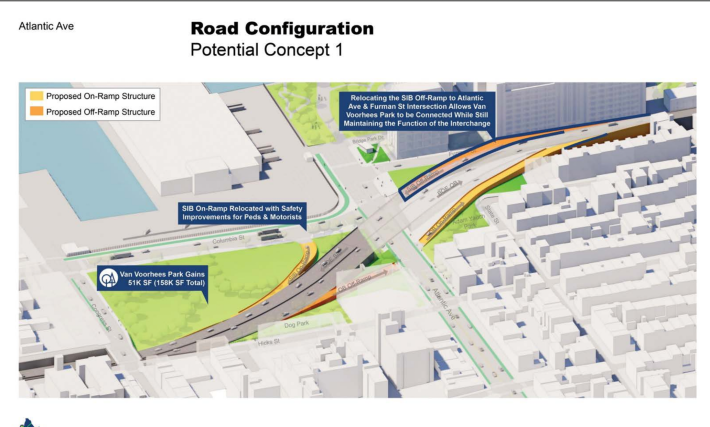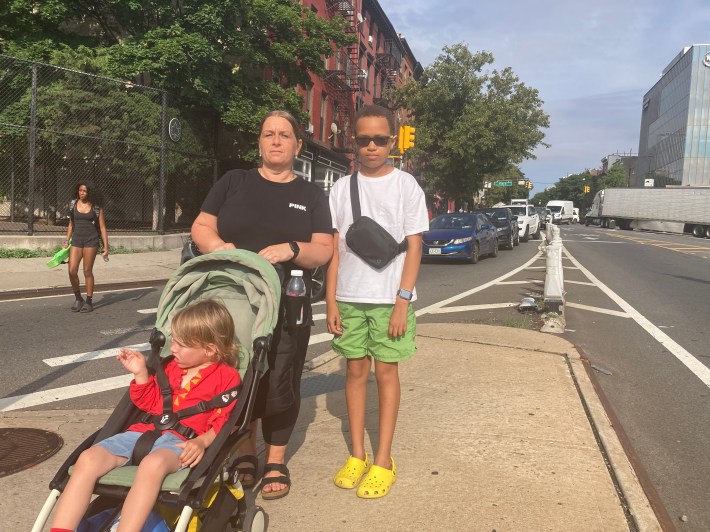A city plan to redesign the Brooklyn-Queens Expressway's much-maligned Atlantic Avenue interchange comes “right out of the Robert Moses playbook” because it proposes building new — rather than eliminating — highway ramps, pols and experts charge.
Two out of the three concepts the Department of Transportation unveiled earlier this month would build a new highway off-ramp on Hicks Street, south of Atlantic, sending even more traffic down a residential street, and doing nothing to curb the number of gas-guzzling cars and trucks that traverse the 1950s-era highway every day.
“I don't understand the purpose of any of these proposed changes. They don't improve safety, they don't improve traffic, and they certainly don't improve any of the surrounding communities,” said former DOT Commissioner Hank Gutman, who also sat on ex-Mayor de Blasio’s so-called expert panel tasked with dreaming up a fix for the beleaguered BQE.
Before finalizing the three designs presented to community members on June 15, the DOT did study other, bolder ideas for the interchange — considered the "worst-designed ramps" in the city — including eliminating the BQE bridge over Atlantic Avenue entirely by tucking the highway under the thoroughfare, and adding pedestrian bridges and connections over the BQE. But neither was pursued further, according to the agency.
Even the DOT admitted its own concepts have “trade-offs.” First, a map of the area (zoom in for detail) and then a breakdown of the concepts:
Concept One
Concept one represents the least amount of changes to the existing infrastructure. It would relocate the interchange’s Staten Island-bound on-and-off ramps that currently cleave Van Voorhees Park by creating a new Staten Island-bound off-ramp on the north side of Atlantic Avenue and shifting the Staten Island-bound on-ramp north within Van Voorhees Park, allowing for an enlarged and reconnected green space (see photo below):

It would also reduce pedestrian crossing distances by eliminating the slip lanes at the existing Queens-bound on-and-off-ramps (see photo below):

But according to DOT, concept one would “only marginally” improve some of the area’s existing challenges, like congestion, by keeping much of the current infrastructure intact.




Concept Two
The second concept builds off the first, but adds the controversial new Queens-bound on-ramp at the intersection of Hicks and Congress streets, and also allows for shortened crossings near the Queens-bound on-and-off ramps. Further, it would split Furman Street, and widen the bridge over the BQE on Congress Street to “accommodate expected new volume of vehicles.”
“It’s right out of the Robert Moses playbook. I was not impressed. It brings the traffic and the pollution closer to people's homes,” said Assembly Member Jo Anne Simon (D-Brooklyn Heights). “They need to go back to the drawing board.”




Concept Three
And the third concept, which represents the most significant change to the existing infrastructure, would introduce new ramps in both directions near Hicks and Congress streets, and, pending approval from the state and feds, remove the existing Queens-bound on-ramp to the BQE, as part of one variation. In the second variation, Congress Street would become two-way, allowing cars and trucks to directly access Columbia Street.





All of the concepts include a “buffered or protected” bike lane along that stretch of Atlantic Avenue in both directions.

But whether any of the proposed design changes will actually make the notoriously deadly corridor safer or not is unclear. In April, a speeding motorist fatally struck 31-year-old Katherine Harris as she crossed near Clinton Street. The DOT’s presentation says its plans both "improve walking conditions" and "create a more challenging pedestrian experience.”
“This misses the mark. The proposals should not be doubling down on the infrastructure and transportation of the past,” said state Sen. Andrew Gounardes (D-Brooklyn Heights). “The community has very deep concerns about what has to happen at Atlantic Avenue and DOT needs to go back to the drawing board. Proposing putting a ramp on Hicks Street, which is where people live, that is the legacy of Robert Moses.”
One mom, who was attempting to walk west on Atlantic Avenue near the Queens-bound on-ramp last week, told Streetsblog that she’s dubious of any plan to improve the dangerous intersections.
“It takes a little while to cross the street, and you have to be very careful because (the cars) are coming from different directions. I wish something is done. But you know, nothing will be done until something happens,” said Kathy Kovac, who lives in Park Slope and was walking with her son Correy and another child she babysits.

And Carlo Scissura, the president and CEO of the New York Building Congress, who chaired de Blasio’s expert panel and has called for tearing down the dilapidated highway altogether, wouldn’t go as far as Gutman to criticize the city’s designs, but said he hopes it comes up with something “better.”
“We talked a lot about that entrance and exit on Atlantic Avenue. It is a very dangerous one, it is really in the middle of a residential community,” Scissura said. “I’m hopeful that something better would come out.”
He added that the city should first finalize its long-awaited plans for the triple cantilever section of the expressway — including whether it will be two or three lanes in each direction, or require the construction of an interim highway — before attempting to tackle the treacherous Atlantic Avenue interchange.
“You almost can't design Atlantic Avenue without understanding what's happening on the triple cantilever. I think it's a little premature,” he said.






